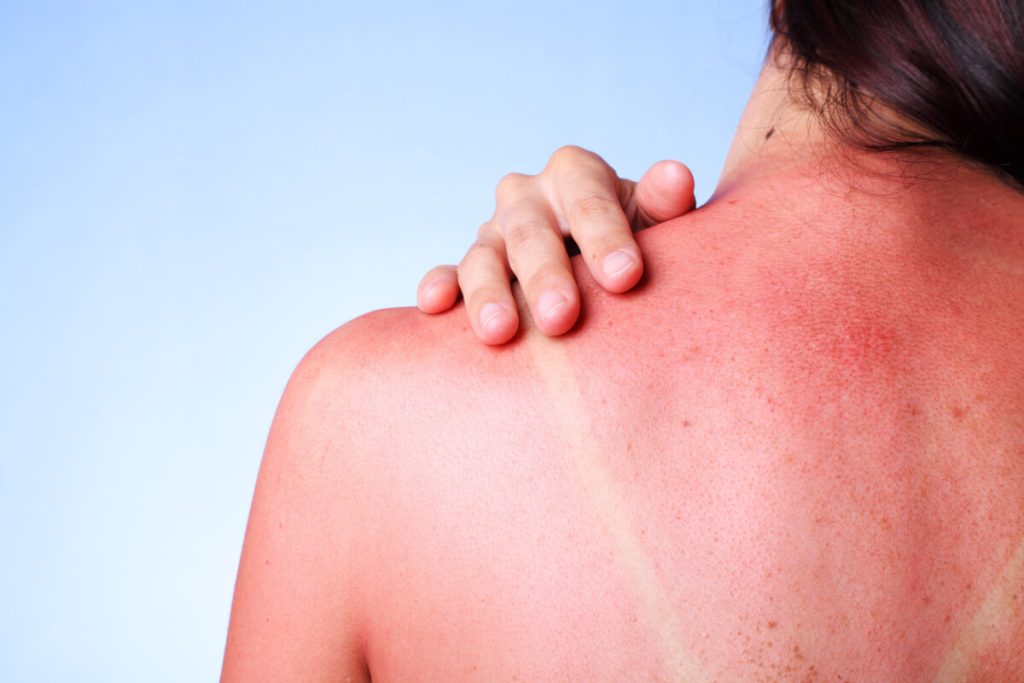

(© jivimages – stock.adobe.com)
‘We need to rewrite the textbooks,’ study authors proclaim
In a nutshell
- Scientists discovered that the immediate inflammatory response in sunburns is triggered by RNA damage rather than DNA damage as previously thought, challenging decades of scientific understanding about how UV radiation affects skin.
- The research identified a protein called ZAKα as the key molecular sensor that detects UV-damaged RNA and initiates the inflammatory cascade leading to sunburn symptoms, with mice lacking this protein showing significantly reduced inflammation after UV exposure.
- This discovery could lead to new treatments for sunburns and other inflammatory skin conditions that worsen with sun exposure, as targeting the ZAKα pathway might help prevent or reduce severe skin inflammation.
COPENHAGEN — Most people associate sunburns with DNA damage — it’s what we’ve been taught in textbooks and by dermatologists for years. However, surprising new research suggests that it’s actually RNA damage triggering the acute inflammatory reactions we experience as sunburn.
A team of researchers from the University of Copenhagen and Nanyang Technological University, Singapore investigated how skin cells respond to UV exposure, focusing on a protein called ZAKα. This protein acts as a cellular stress sensor, detecting when UV radiation has damaged messenger RNA (mRNA) molecules involved in protein production. Unlike DNA, which is long-lived and passes mutations down to future cells, RNA is more transient and experiences damage regularly without causing permanent mutations.
“Sunburn damages the DNA, leading to cell death and inflammation. So the textbooks say. But in this study we were surprised to learn that this is a result of damage to the RNA, not the DNA that causes the acute effects of sunburn,” explains Anna Constance Vind, an assistant professor from the Department of Cellular and Molecular Medicine at Copenhagen, in a statement.
The study, published in Molecular Cell, revealed that mRNA damage triggers a response in ribosomes — cellular protein-making factories — orchestrated by ZAKα through what’s called the ribotoxic stress response. This surveillance system within cells registers RNA damage, leading to inflammatory signaling and immune cell recruitment that causes skin inflammation.


To investigate this mechanism, the researchers used genetically modified mice lacking the ZAK gene. When exposed to UV radiation, these mice showed significantly reduced skin inflammation compared to normal mice in the first few hours after exposure. The modified mice also exhibited less thickening of the epidermis – a typical response to UV damage where skin cells multiply to replace damaged ones.
“We found that the first thing the cells respond to after being exposed to UV radiation is damage to the RNA, and that this is what triggers cell death and inflammation of the skin,” says Simon Bekker-Jensen, a professor from Copenhagen’s Cellular and Molecular Medicine department. “When we removed the ZAK gene, these responses disappeared, which means that ZAK plays a key role in the skin’s response to UV-induced damage.”
The research team also examined human skin cells in laboratory conditions. They found that UV exposure activated two distinct cell death pathways through ZAKα: apoptosis (controlled cell death) and pyroptosis (inflammatory cell death). Importantly, blocking ZAKα activity protected cells from both forms of death, while blocking DNA damage responses had minimal effect on immediate cell survival.
This discovery represents what Vind calls “quite the paradigm shift” in our understanding of how skin responds to UV damage. The RNA-based response appears to be faster and more effective at protecting skin from further damage than previously understood DNA damage pathways.
“Understanding how our skin responds at the cellular level to UV damage opens the door to innovative treatments for certain chronic skin conditions,” notes co-author Dr. Franklin Zhong from NTU’s Lee Kong Chian School of Medicine.
The research also revealed an elegant negative feedback mechanism: after activation, ZAKα triggers its own destruction, which helps limit the inflammatory response. This self-regulating system prevents excessive inflammation while allowing enough of a response to deal with the initial damage.
“This new knowledge turns things upside down,” Bekker-Jensen concludes, “Now we need to rewrite the textbooks, and it will affect future research on the effects of UV radiation on the skin.”
Paper Summary
Methodology
The researchers used a combination of genetic and molecular biology techniques to study UV responses in both mice and human cells. They created mice lacking the ZAK gene and exposed their skin to controlled UV doses, measuring inflammation markers and cellular responses. They also cultured human skin cells in laboratory conditions, manipulating various cellular pathways to understand their roles in UV response. Advanced imaging techniques and molecular markers were used to track different types of cell death and inflammatory responses.
Results
The study found that ZAKα activation is necessary for the acute inflammatory response to UV exposure. Mice lacking ZAKα showed reduced inflammation and skin thickening after UV exposure. In human cells, ZAKα activated both apoptotic and pyroptotic cell death pathways. The research also revealed that ZAKα triggers its own degradation as a negative feedback mechanism.
Limitations
The study primarily focused on acute responses to UV exposure and did not extensively investigate long-term effects. While mouse models are valuable research tools, they don’t perfectly replicate human skin responses. Additionally, the research was conducted under controlled laboratory conditions, which may not fully reflect real-world UV exposure scenarios.
Discussion and Takeaways
This research fundamentally changes our understanding of how sunburns develop at the cellular level. The discovery that RNA damage triggers a faster and more effective response than DNA damage pathways represents a significant shift in our understanding of skin’s defense mechanisms. While DNA damage remains important for long-term UV effects, the immediate inflammatory response appears to be primarily driven by RNA damage sensing through ZAKα. This opens new possibilities for treating severe sunburns and other inflammatory skin conditions by targeting this pathway.
Funding and Disclosures
The research was supported by multiple organizations including the LEO Foundation, the European Research Council, the National Danish Research Foundation, and others. The authors declared no competing interests.
Publication Information
This study was published in Molecular Cell (Volume 84, pages 4774-4789, December 19, 2024) under the title “The ribotoxic stress response drives acute inflammation, cell death, and epidermal thickening in UV-irradiated skin in vivo” by Vind et al.







